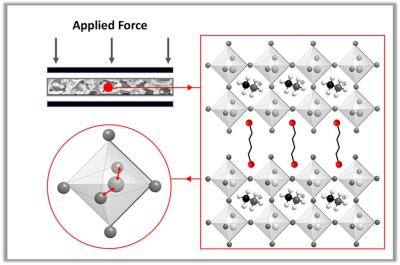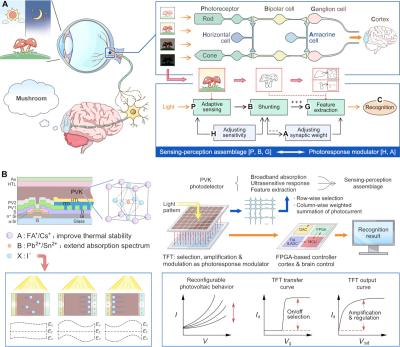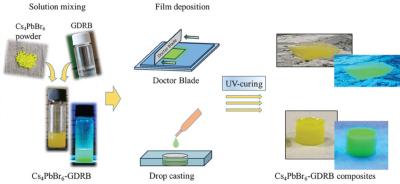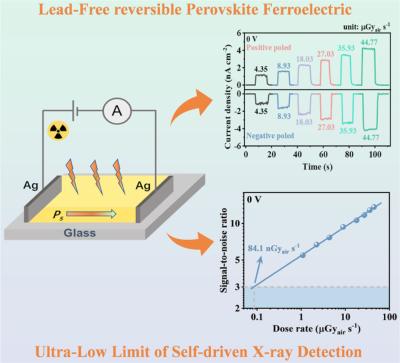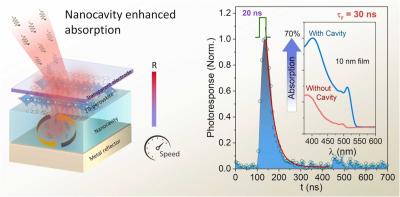Perovskite sensors
Perovskites are materials that share a crystal structure similar to the mineral called perovskite, which consists of calcium titanium oxide (CaTiO3).
Depending on which atoms/molecules are used in the structure, perovskites can possess an impressive array of interesting properties including superconductivity, ferroelectricity, charge ordering, spin dependent transport and much more. Perovskites therefore hold exciting opportunities for physicists, chemists and material scientists.

Sensors are devices that detect events that occur in the physical environment (like light, heat, motion, moisture, pressure, and more), and respond with an output, usually an electrical, mechanical or optical signal. The household mercury thermometer is a simple example of a sensor - it detects temperature and reacts with a measurable expansion of liquid. Sensors are everywhere - they can be found in everyday applications like touch-sensitive elevator buttons and lamp dimmer surfaces that respond to touch, but there are also many kinds of sensors that go unnoticed by most - like sensors that are used in medicine, robotics, aerospace and more.
Traditional kinds of sensors include temperature, pressure (thermistors, thermocouples, and more), moisture, flow (electromagnetic, positional displacement and more), movement and proximity (capacitive, photoelectric, ultrasonic and more), though innumerable other versions exist. sensors are divided into two groups: active and passive sensors. Active sensors (such as photoconductive cells or light detection sensors) require a power supply while passive ones (radiometers, film photography) do not.
Perovskite materials’ host of exciting properties, such as being rather tolerant to defects (unlike metal chalcogenides) and not requiring surface passivation to retain high quantum yields, make them especially suited for sensing applications. The sensitivity, selectivity, and stability of many perovskite nanomaterials has directed many researchers to devote the most attention to chemical sensors, but perovskites are suitable for other types as well. Perovskites are being studied by numerous research groups for use in various types of sensors.
IIT Guwahati team uses perovskites for mercury detection in cells and environment
Researchers from the Indian Institute of Technology Guwahati have reportedly developed a perovskite-based approach to detecting harmful metals like mercury in living cells and the environment.
The team relied on perovskites' unique interaction with light, which enables them to serve as fluorescent probes inside living cells. However, their quick degradation in water has previously limited their applications. To address this, the researchers encapsulated the perovskite nanocrystals in silica and polymer coatings, significantly enhancing their stability and luminescent intensity in water. This modification ensures the nanocrystals maintain their functionality over extended periods, making them highly effective for practical use.
Perovskite-based smart eyeglasses can detect eye position without cameras
Researchers from the Beijing National Laboratory for Molecular Sciences (BNLMS), CPU Hydrogen Power Technology (Suzhou), Fudan University, Chinese Academy of Sciences and Zhengzhou University have developed smart glasses that track eye position using arrays of perovskite light sensors instead of cameras or contact lenses. Their system measures light reflected from the eyeball to determine gaze direction with five-degree precision.
The researchers solved a key materials challenge by developing a novel crystal growth method inspired by biological mineralization processes. They added a layer of polyacrylic acid sodium (PAAS) that guides perovskite crystals to form in larger, more organized structures – similar to how sea creatures control shell formation. This resulted in methylammonium lead iodide films with superior light-detecting capabilities.
Researchers examine the effect of barrier molecule types and dimensionality in hybrid perovskite on the piezoelectric properties
Hybrid perovskites show piezoelectric properties due to polarization and centro-symmetry breaking of PbX6 pyramids (X = I-, Br-, Cl-). Researchers from The Hebrew University of Jerusalem, Polish Academy of Sciences and Nanyang Technological University recently examined the piezoelectric response of quasi-2D perovskites using various barrier molecules: benzyl amine (BzA), phenylethyl amine (PEA), and butyl diamine (BuDA).
Utilizing piezoelectric force microscopy measurements, the team determined the piezoelectric coefficient (d33) where BuDA exhibits a substantial response with values of 147 pm V–1 for n = 5, better than the other quasi-2D and 3D perovskite counterparts. Density functional theory calculations revealed distorted bond angles in the PbBr6 pyramids for quasi-2D perovskites, enhancing symmetry breaking.
Novel retinomorphic computing hardware uses perovskite sensors
Researchers from Shanghai Jiao Tong University, Hefei University of Technology, Korea Advanced Institute of Science and Technology and Tianjin Jinhang Computing Technology Research Institute have developed a retinomorphic hardware prototype that uses a 4096-pixel perovskite image sensor array as core module to endow embodied intelligent vision functionalities.
(A) Adaptive sensing-perception by the biological visual system through the hierarchy of photoreceptors, horizontal cells, bipolar cells, amacrine cells, and ganglion cells. (B) Schematic illustration and working principle of the retinomorphic computing system based on a 4096-pixel 1T-1PD perovskite RSA, microcontroller unit (MCU), and field-programmable gate array (FPGA). ADC, analog-to-digital converter; TIS, trans-impedance amplifier; DAC, digital-to-analog converter. Image from: Science Advances
The team explained that retinomorphic systems that can see, recognize, and respond to real-time environmental information could extend the complexity and range of tasks that an exoskeleton robot can perform to better assist physically disabled people. However, the lack of ultrasensitive, reconfigurable, and large-scale integratable retinomorphic devices and advanced edge-processing algorithms makes it difficult to realize retinomorphic hardware.
Researchers 3D print customizable radiation detectors based on perovskite materials
Radiation detectors, which convert radiation into measurable light signals, currently come in fixed shapes like blocks or cylinders because they are made by growing crystals at extremely high temperatures – around 1700 °C. These rigid shapes make it difficult to measure radiation doses accurately around irregularly shaped tumors or in tight spaces. Previous attempts to create detectors in custom shapes have focused on plastic materials that can be easily molded, but these plastic detectors perform poorly because they lack the heavy elements needed to efficiently capture radiation. Scientists have tried mixing metal particles into plastics to improve their detection ability, but this often results in uneven distribution of the particles and poor overall performance.
A research team from several institutions in Italy and Switzerland has now developed a new approach using stereolithography (SLA), a precise form of 3D printing that builds objects by hardening light-sensitive liquid materials layer by layer. This marks the first successful use of SLA to fabricate 3D-printed scintillators, a breakthrough in radiation detection technology. The team mixed microscopic crystals of cesium lead bromide (Cs4PbBr6), a perovskite material, into a liquid resin that hardens when exposed to ultraviolet light. Perovskites have gained significant attention in recent years because they efficiently convert various forms of energy into light. Their crystal structure, which contains heavy elements like lead, makes them particularly effective at detecting radiation.
Chinese researchers use perovskites to develop polarization photodetectors mimicking desert ant
Researchers from the Chinese Academy of Sciences (CAS), Beihang University and Imperial College London have developed an on-chip integrated polarization photodetector (pol-PD), drawing inspiration from the unique polarization vision of desert ants.
Working mechanism diagram of the single-shot on-chip pol-PD. Image from Science Advances
Pol-PDs have widespread applications in geological remote sensing, machine vision and biological medicine. However, commercial pol-PDs usually require bulky and complicated optical components and are difficult to miniaturize and integrate. The researchers observed that desert ants can navigate back to their nests across barren landscapes without landmarks, thanks to their compound eyes' ability to detect polarized sunlight. They aimed to mimic this capacity with their pol-PD.
Researchers develop self-driven X-ray detection device using high resistivity zero-dimensional lead-free perovskite
Researchers from China's Jiangxi Normal University, Chinese Academy of Sciences (CAS) and City University of Hong Kong have developed a self-driven X-ray detection device using high resistivity zero-dimensional lead-free perovskite ferroelectric single-crystal (NMP)3Sb2Br9. The device exhibits an excellent self-driven X-ray detection performance, with an ultra-low detection limit of 84.1 nGyair/s, approximately 60 times lower than that of commercial α-Se (5500 nGyair/s).
The self-driven detection mode without external bias has been proven to be an effective means of reducing the limit of detection (LoD) due to its low current noise characteristics. Additionally, the zero-dimensional distinctive isolated framework results in a high resistivity of 1.39 × 1011 W cm, which effectively reduces the current noise and suppresses ion migration.
Researchers combine 2D metal halide perovskites with nanocavities to develop efficient self-powered 2D-perovskite photodetectors
Researchers from King Abdullah University of Science and Technology (KAUST), the University of Manchester and Marvell Semiconductor have developed an innovative high-speed photodetector design utilizing ultrathin two-dimensional metal halide perovskites (2D-MHP), coupled with a planar nanocavity to significantly enhance optical absorptance—achieving more than a fourfold increase in a solution-processed 10-nm-thick 2D-MHP film.
This integration facilitates an exceptional response time (30 ns) alongside a high responsivity of 2.12 A W−1. The method is said to overcome traditional constraints related to thickness and absorption, thereby optimizing device speed and dark noise features through active area variation.
New method for spontaneous cooling enables high-quality perovskite wafers for X-Ray detectors
Researchers from China's Dongguan University of Technology and Xi'an Jiaotong University have developed a spontaneous cooling strategy with a hot-pressing technique that enables the production of high-purity, wafer-scale, pinhole-free perovskite wafers with a reflective surface.
This method can, according to the team, be extended to a variety of perovskite wafers, including organic-inorganic, 2D, and lead-free perovskites. The size of the wafer (with diameters of 10, 15, and 20 mm) can be tailored by changing the mold.
Project aims to replace sensors’ batteries with perovskite solar cells
An NSW Smart Sensing Network Grand Challenge Fund project is hoping to eliminate the reliance of sensors on disposable batteries by testing the fast production of perovskite photovoltaic (PV) cells, in the hope of creating a more sustainable sensor power source. The NSW Smart Sensing Network, a consortium of eight leading universities across NSW and the ACT, is a not-for-profit innovation network that brings together universities, industry and government to translate world-class research into innovative smart sensing solutions that create value for NSW and beyond.
The Revolutionizing Indoor Sensor Power: Rapid Microwave Annealing for Ultra-low-cost Perovskite Solar Cells project is being led by Dr. Binesh Veettil, a Senior Lecturer in the School of Engineering at Macquarie University. “Perovskite cells offer continuous power, and are ideal for harvesting indoor light to power low-power sensors,” Dr. Veettil says. “They are cost-effective when mass manufactured and they are suitable for roll-to-roll manufacturing as they can be screen-printed, slot-die coated, or spray-painted. Unfortunately the lengthy annealing time required is a challenge to be addressed to enable their widespread adoption.”
Pagination
- Page 1
- Next page


